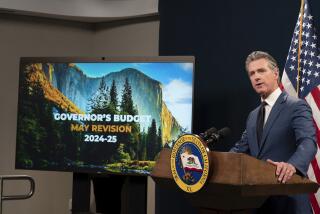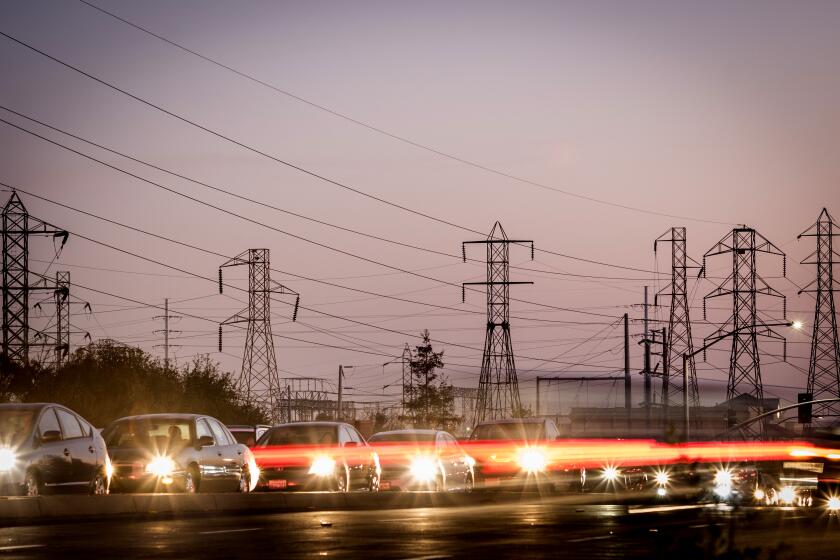Safety Net for Jobless More Porous
Texas’ unemployment insurance fund appears headed for insolvency. So does New York’s. More than a dozen states have little or no money for extra welfare benefits in case of recession, and the federal program designed to back them up expired over the weekend.
Such is the condition of America’s social safety net as the economy teeters on the edge of recession--at least in part because of the Sept. 11 terrorist attacks--and the jobless rate climbs.
“Much of the country isn’t ready to weather a downturn,” said Jeffrey B. Wenger, an economist with the Economic Policy Institute, a labor-backed, Washington think tank.
Problems range across the spectrum of government programs Americans have come to rely on during economic bad times, such as unemployment insurance, welfare, food stamps and Medicaid. As a result, millions could find their benefits harder to obtain and less generous while state and federal governments scramble to find money to fill in the gaps in these programs.
The immediate focus of the Bush administration is averting a crisis over jobless benefits. The president met Friday with Labor Secretary Elaine Chao and others to review proposals for an extra 13 weeks of unemployment compensation and more aid for the hundreds of thousands of workers dislocated by the attacks.
But analysts warn that extra benefits are likely to be overwhelmed by additional needs if the economy further erodes. The reason: Congress and the states have spent much of the last decade scaling back safety net programs.
“If there are no changes, the safety net is likely to be much more restrictive than it was in the last recession,” said Sheldon Danzinger, a public policy professor at the University of Michigan and longtime observer of the nation’s welfare system. “That means fewer people getting benefits.”
It could also increase the odds of the economic nightmare scenario: a downward cycle in which American consumers, already concerned about a slowdown and shaken by the attacks, begin worrying there will be nothing to break their fall should they stumble, and sharply curtail their spending, leaving companies no choice but to order new layoffs.
Usual Responses May Not Work
Such worries would leave consumers impervious to the usual enticements to return to shopping--low interest rates and continued employment. It would blunt Washington’s customary weapons against recession--interest rate reductions, tax cuts and new spending.
Besides effectively trimming unemployment insurance, the state and federal governments have weakened the social safety net in a variety of other ways as well:
* The 1996 federal welfare reform law imposed a five-year lifetime limit on the right to collect welfare benefits. The aim was to end dependency and force able-bodied adults to work. The measure succeeded in slashing welfare rolls by half, but time is running out for many people as they try to find jobs just as the job market is coming unstuck. As a result, several million poor mothers and others could find themselves without paychecks or welfare payments.
* Authors of the 1996 law, acknowledging that welfare costs rise in recessions, created a $2-billion federal “contingency” fund to help states through downturns. But they gave the fund a five-year life, which ended Sunday. No one has proposed an extension. States were also supposed to build up recession reserves of their own. But 16 have saved little or nothing and another 10 have only enough to cover six months of benefits in nonrecessionary times, according to government statistics and a new study by the Center on Budget and Policy Priorities, a Washington think tank.
* Washington has placed new restrictions on food stamps, which helped millions weather past recessions. The states have followed up with even tighter rules. Among other things, even legal immigrants are now prohibited from receiving government food assistance. Since 1996, the ban has helped cut the food stamp rolls by one-third to 17 million. But it has caused comparatively little pain because of the ease with which most people have been able to find jobs in recent years. With unemployment now rising, that is likely to change, especially in high-immigration areas like Southern California.
In the case of unemployment insurance, analysts say that a system already in trouble because of initiatives by President Reagan and others during the 1980s, was further damaged in the 1990s when states failed to use the economic good times to salt away savings.
Unemployment insurance is the principal safety net for workers who lose their jobs through no fault of their own, and covers 90% of the nation’s 140 million workers. Each state runs its own program and sets its own benefits, which vary widely. Benefits are generally available for up to 26 weeks. The costs are covered by a tax on employers, as well as federal loan funds. Analysts say those funds will protect the system from a collapse.
Texas Faces Funding Gap
The problems are most extreme in Texas, where officials acknowledged last week that the combination of an employer tax cut supported by then-Gov. George W. Bush last year and a recent jump in jobless benefit claims is draining the state’s Unemployment Compensation Trust Fund.
Larry Jones, a spokesman for the Texas Workforce Commission, which administers the fund, portrayed the problem as little more than a technical glitch and asserted that workers’ benefits are not threatened. “We choose to operate close to the floor so we don’t have money sitting around,” he said.
But state officials were forced to reverse course and announce they will raise taxes on employers and divert funds from a jobs training program to address the shortfall. Even with the extra money, several independent analysts said, the state program is unlikely to avoid insolvency.
“They’ll never make it,” said Phillip Levine, a Wellesley College economist who recently completed a study of unemployment compensation during the last three recessions.
“For 10 years, Texas and a handful of other states have done everything they could not to save any money, and now they’re paying the price,” Levine said.
Chief among the other states is New York, whose unemployment insurance system is in almost as rocky shape as Texas’. One measure of its troubles: The U.S. Labor Department recommends states keep enough money on hand to cover 52 weeks of benefits during a recession. But at the end of March, before unemployment began climbing sharply and well before the suicide airliner attacks on the World Trade Center disrupted its economy, New York had only enough for about 16 weeks. (Texas had only enough for about 14 weeks.)
New York Labor Department spokesman Robert Lillpopp said Friday that state officials are “discussing what our options are” with federal officials. U.S. Assistant Labor Secretary Emily DeRocco said her department has adequate funds to make loans to New York and other states in trouble to assure benefits are paid. White House officials suggested that Washington may ultimately provide New York with outright grants to cover many of the costs associated with the attacks, including higher unemployment benefits.
However, federal loans and grants alone may not be enough to allow jobless Americans to ride out the coming economic trouble without substantial discomfort. That’s because many states that do have adequate funds to cover the jobless benefits they offer have set those benefits at such low levels that analysts say they offer precious little protection.
One of the chief offenders is California, whose $230 maximum weekly benefit is among the lowest in the nation, according to government statistics. The amount is not enough to replace even one-quarter of the $50,000-plus annual incomes many in the high-tech and airline industries were making before being laid off. It is nowhere near enough to provide the 40% replacement rate many analysts say should be a target for jobless benefits.
The California Legislature recently approved a measure to raise the maximum benefit to $450 over four years, and Gov. Gray Davis is expected to sign it today.
With unemployment reaching a four-year high of 4.9% nationally in August and expected to go still higher when September numbers are announced Friday, the issues of how generous benefits are and whether the money is available to pay them are likely be a growing concern to working Americans.
But some analysts fear that the nation’s governors, who won new powers over the country’s most important safety net programs during the 1990s, may not be up to the task of expanding them. Many state chief executives, including the current president, made their political reputations by cutting taxes and benefit rolls.
And these analysts wonder whether a federal government already strapped by a substantial tax cut and the launch of a long struggle against terrorism will have the resources to help.
“What I worry about is that states will get very miserly when they see their state [unemployment insurance] funds dwindling, and solve the problem by tightening eligibility and cutting benefits,” said Princeton economist Alan B. Krueger.
If that happens, working Americans could be in for a painful time, even if the recession proves comparatively short.
(BEGIN TEXT OF INFOBOX / INFOGRAPHIC)
Ready for Recession?
States with the highest and lowest unemployment compensation benefits (for the year 2000).
Lowest weekly maximum benefit
Alabama $190 Mississippi 190 Arizona 205 South Dakota 224 CALIFORNIA 230*
Highest weekly maximum benefit
Massachusetts $477 Washington 441 Pennsylvania 430 New Jersey 429 New York 405
*Will rise to $450 by 2005 Source: Labor Department, Economic Policy Institute
More to Read
Get the L.A. Times Politics newsletter
Deeply reported insights into legislation, politics and policy from Sacramento, Washington and beyond. In your inbox three times per week.
You may occasionally receive promotional content from the Los Angeles Times.






